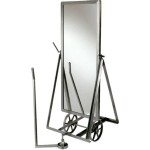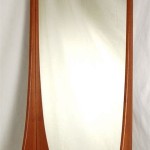Vintage Hand Mirrors: A Reflection of History and Style
Vintage hand mirrors, more than just functional objects, are captivating artifacts reflecting changing aesthetic preferences, technological advancements, and social customs throughout history. These mirrors, varying in size, shape, and ornamentation, provide a tangible link to the past, offering a glimpse into the daily lives and beauty rituals of previous generations. The enduring appeal of vintage hand mirrors stems not only from their decorative value but also from their capacity to evoke nostalgia and a sense of connection to bygone eras. Examining these objects allows exploration of the evolution of design, craftsmanship, and the cultural significance of personal grooming.
The history of hand mirrors extends back millennia, with early examples appearing in ancient civilizations like Egypt, Greece, and Rome. These early mirrors were typically crafted from polished metal, such as bronze, copper, or silver. The reflective surface was meticulously buffed to achieve the desired clarity. While providing a functional reflective surface, these early mirrors were also objects of status and luxury, often adorned with intricate carvings and precious stones. The discovery of glassblowing and the subsequent silvering process significantly impacted mirror production, allowing for larger, clearer, and more affordable mirrors.
The emergence of glass mirrors gradually replaced metal mirrors, leading to new design possibilities and styles. Frame materials expanded to include wood, ivory, bone, and various metals, each reflecting the prevailing aesthetic trends of the time. The Victorian era, in particular, saw the rise of elaborately decorated hand mirrors, reflecting the ornate and sentimental sensibilities of the period. Art Nouveau and Art Deco styles further transformed hand mirror design, incorporating flowing lines, geometric patterns, and exotic materials.
Craftsmanship and Materials: Distinguishing Features
The value and appeal of vintage hand mirrors are often determined by the quality of craftsmanship and the materials used in their construction. Examining these features provides valuable insights into the object's age, origin, and potential worth. The mirror's frame, handle, and embellishments are of particular importance in this assessment.
Early hand mirrors, particularly those from the 18th and 19th centuries, often showcase meticulous handcraftsmanship. Skilled artisans would carve intricate designs into wood or ivory frames, employing techniques such as relief carving, openwork, and marquetry. Metal frames, typically made of silver, brass, or pewter, might feature repoussé work, engraving, or chasing, creating detailed and textured surfaces. The quality of the metal itself is also a factor, with sterling silver or high-grade brass commanding higher prices.
The choice of materials also reflects the prevailing aesthetic trends and the intended market for the mirror. For instance, mirrors intended for wealthy patrons might feature frames inlaid with precious stones, mother-of-pearl, or enamel. More affordable mirrors might utilize less expensive materials such as celluloid, Bakelite, or painted wood. The type of glass used in the mirror itself can also be indicative of its age. Early glass mirrors often exhibit slight imperfections or variations in thickness, which are characteristic of hand-blown glass. Modern mirrors, produced with automated processes, tend to have a more uniform and flawless surface.
Examining the joints and connections between the frame, handle, and mirror glass can also provide clues about the mirror's construction and quality. Hand-fitted joints, such as dovetail joints or mortise-and-tenon joints, are indicative of high-quality craftsmanship. Similarly, the method used to secure the mirror glass within the frame can offer insights. Early mirrors often used putty or glazing compound to hold the glass in place, while later mirrors might utilize clips or adhesive.
Identifying Period Styles: A Timeline of Design
Vintage hand mirrors reflect the stylistic evolution of design across different historical periods. Recognizing these stylistic features is essential for accurately dating and appreciating the historical context of these objects. From the austere elegance of the Georgian era to the bold geometry of Art Deco, hand mirrors bear the imprint of changing aesthetic sensibilities.
Georgian hand mirrors (roughly 1714-1830) often display a restrained elegance, characterized by symmetrical designs and classical motifs. Frames might be made of mahogany, walnut, or giltwood, with simple moldings and minimal ornamentation. Neoclassical influences, drawing inspiration from ancient Greek and Roman art, are also common during this period. Common decorative elements include acanthus leaves, swags, and urns.
Victorian hand mirrors (1837-1901) reflect the era's penchant for elaborate ornamentation and sentimental themes. Frames are often densely decorated with floral motifs, scrolls, and figural elements. Materials such as silver plate, tortoiseshell, and mother-of-pearl are frequently employed. The use of plush fabrics, such as velvet or silk, to line the backs of mirrors is also characteristic of this period. Furthermore, the Victorian era saw a revival of various historical styles, including Gothic Revival, Renaissance Revival, and Rococo Revival, each contributing to the diversity of hand mirror designs.
Art Nouveau hand mirrors (approximately 1890-1910) are distinguished by their flowing lines, organic forms, and stylized floral motifs. Designs often incorporate whiplash curves, symbolic representations of nature, and depictions of female figures with flowing hair. Materials such as pewter, copper, and enamel are frequently used, often combined with glass or semi-precious stones. Artists and designers sought to create objects that were both functional and aesthetically pleasing, blurring the boundaries between art and craft.
Art Deco hand mirrors (1920s-1930s) embrace geometric shapes, streamlined designs, and bold colors. Frames often feature stepped forms, stylized sunbursts, and zig-zag patterns. Materials such as chrome, Bakelite, and glass are commonly used. The influence of cubism, futurism, and other avant-garde art movements is evident in the designs. Art Deco mirrors reflect the era's fascination with modernity, technology, and speed.
Collecting and Caring for Vintage Hand Mirrors
The appeal of vintage hand mirrors extends to collectors and enthusiasts who appreciate their historical significance and aesthetic value. Building a collection of vintage hand mirrors involves careful research, informed purchasing decisions, and proper care to preserve the objects' condition. The process of acquiring, preserving, and displaying these mirrors engages both the intellect and the senses.
Before embarking on a collection, it is essential to conduct thorough research on different styles, periods, and manufacturers of vintage hand mirrors. Familiarizing oneself with the characteristics of various eras, as well as the marks and signatures of prominent designers and makers, can aid in identifying authentic pieces and avoiding reproductions or fakes. Antique shops, estate sales, online auctions, and specialty shows are potential sources for acquiring vintage hand mirrors. It is advisable to carefully examine each mirror before purchase, paying attention to the condition of the frame, glass, and any embellishments. Evidence of damage, such as chips, cracks, or repairs, can significantly impact the value of the mirror.
Proper care is essential for preserving the condition of vintage hand mirrors. Avoid exposing mirrors to extreme temperatures, humidity, or direct sunlight, as these conditions can cause damage to the frame, glass, and silvering. Cleaning mirrors with harsh chemicals or abrasive cleaners can also damage the reflective surface. Instead, use a soft, lint-free cloth dampened with a mild glass cleaner. For frames made of wood, metal, or other materials, use appropriate cleaning products designed for those specific materials. Regularly dusting the mirror and frame can help prevent the buildup of dirt and grime.
Displaying vintage hand mirrors can enhance their aesthetic appeal and showcase their historical significance. Consider arranging mirrors of different sizes, shapes, and styles together to create a visually interesting display. Mirrors can be hung on walls, placed on shelves, or displayed on stands. Proper lighting can also accentuate the beauty of the mirrors and highlight their details. It is important to handle mirrors with care to prevent damage during display. Avoid placing mirrors in areas where they are likely to be bumped or knocked over. By following these guidelines, collectors can ensure that their vintage hand mirrors remain cherished objects for generations to come.

Vintage Hand Mirror Art

Vintage French Inspired Handheld Mirror Apollobox

Hand Mirror Vintage Handheld With Handle Vanity Makeup Travel Mirrors Oval Com

Vintage Hand Mirror Silver Plated Handheld Ornate Art Nouveau Style Photo Prop Silverplated Parlor Mirrors

Vintage Hand Mirror Stock Photo Adobe

Personalized Vintage Hand Mirrors Everythingbranded Usa

Intricate Italian Iron Hand Mirror With M Initial 1920s For At 1stdibs Ancient 1920 S Handmirror

Beautiful Hand Mirrors Vintage Mirror Designs

1 Pieces Vintage Handheld Mirror Portable Embossed Flower Hand Held Decorative Mirrors Compact With Handle For Face Makeup Travel Personal Cosmetic Salon Com

Antique Victorian Brass Footed Cherub Hand Mirror








